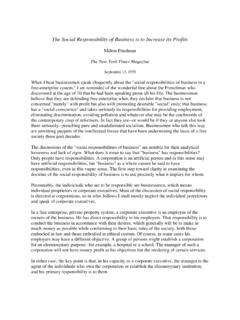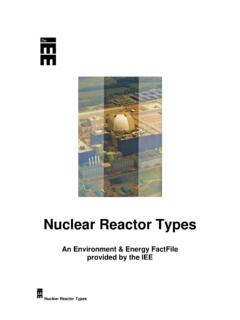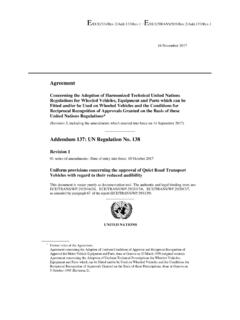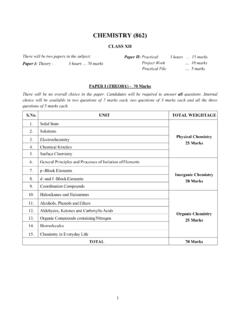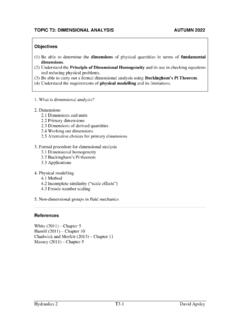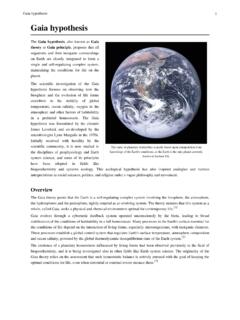Transcription of Le Chatelier’s Principle - Practice Problems for ...
1 Le chatelier 's Principle - Practice Problems for assignment 4. Consider the following equilibrium (1) when answering questions 1 and 2. H2O (l) H2O (g) (1). 1. Which of the following is true about reaction (1)? a. H>0, S>0. b. H>0, S<0. c. H<0, S>0. d. H<0, S<0. 2. Which of the following statement about reaction (1) is true. a. Both enthalpy and entropy favour product. b. Both enthalpy and entropy favour reactant. c. Enthalpy favours product. Entropy favours reactant. d. Enthalpy favours reactant. Entropy favours product 3. Which is true for the following reaction.
2 N2 (g) + 3H2 (g) 2NH3 (g) + heat (2). a. For the reverse reaction, H is negative. b. For the reverse reaction, S is negative. c. Enthalpy favours the reactants. d. Entropy favours the reactants. Consider the following equilibrium when answering questions 4 to 8. N2O4 (g) 2 NO2 (g) H = kJ (3). 4. Which of the following is true about reaction (3) when an amount of NO2 (g) is added to the equilibrium reaction? a. Equilibrium will shift to consume N2O4 (g). b. Equilibrium will shift to produce more NO2 (g). c. Equilibrium will shift to consume the NO2 (g). d. No effect on the equilibrium.
3 5. Which of the following is true about reaction (3) when the pressure is lowered by increasing the volume of the reaction container. a. Equilibrium will produce more N2O4 (g) to offset the pressure drop. b. Equilibrium will shift to the right to produce more NO2 (g). c . Equilibrium will shift to consume more NO2 (g). d. No effect on the equilibrium. 6. Which of the following is true about reaction (3) when the temperature is raised? a. Equilibrium will shift to the left. b. Equilibrium will shift to the right. c. Equilibrium will shift to produce more heat.
4 D. No effect on the equilibrium. 7. Which of the following is true about reaction (3) when a catalyst is added to the system? a. Equilibrium will shift to the left. b. Equilibrium will shift to the right. c. Equilibrium will shift to lower the heat. d. No effect on the equilibrium. 8. Which of the following will increase the Keq of the equilibrium in reaction (3)? a. Add NO2 (g). b. Heat the reaction container. c. Put the reaction container in ice. d. Add a catalyst. Consider the following equilibrium when answering questions 9 and 10. CO (g) + 3 H2 (g) CH4 (g) + H2O (g) (4).
5 9. Which of the following is true about reaction (4) when the concentration of CO. is increased? a. Equilibrium will shift to the left. b. Equilibrium will shift to the right. c. No effect on the equilibrium. D Equilibrium constant will increase. 10. Which of the following is true about reaction (4) when the concentration of CH4 (g) is increased? a. Equilibrium will shift to the left. b. Equilibrium will shift to the right. c. No effect on the equilibrium. d. Equilibrium constant will decrease. Consider the following equilibrium when answering questions 11 and 13.
6 2C2H2 (g) + 5 O2 (g) 4 CO2 (g) + 2 H2O (g) + heat (5). 11. Which of the following is true about reaction (5) when the concentration of O2 (g) is decreased? a. Equilibrium will shift to the left. b. Equilibrium will shift to the right. c. No effect on the equilibrium. d. Equilibrium constant will decrease. 12. Which of the following is true about reaction (5) when the temperature is increased? a. Equilibrium will shift to the left. b. Equilibrium will shift to the right. c. No effect on the equilibrium. d. No effect on the equilibrium constant. 13. Which of the following is true about reaction (5) when the pressure is increased by decreasing the volume of the reaction container?
7 A. Equilibrium will shift to the left. b. Equilibrium will shift to the right. c. No effect on the equilibrium. d. No effect on the heat produced. Consider the following equilibrium when answering questions 14 and 17. 2 H2O (g) + 2 Cl2 (g) + heat 4 HCl (g) + 2 O2 (g) (6). 14. Which of the following is true about reaction (6) when the reaction mixture is heated. a. Equilibrium will shift to the left. b. Equilibrium will shift to the right. c. No effect on the equilibrium. d. No effect on the equilibrium constant. 15. Which of the following is true about reaction (6) when O2 (g) is added to the mixture.
8 A. Equilibrium will shift to the left. b. Equilibrium will shift to the right. c. No effect on the equilibrium. d. Equilibrium constant will decrease. 16. Which of the following is true about reaction (6) when the pressure is increased by the addition of an inert gas? a. Equilibrium will shift to the left. b. Equilibrium will shift to the right. c. No effect on the equilibrium. d. Equilibrium constant will decrease. 17. Which of the following is true about reaction (6) when the size of the reaction container is increased? a. Equilibrium will shift to the left.
9 B. Equilibrium will shift to the right. c. No effect on the equilibrium. d. Equilibrium constant will increase. 18. Consider the reaction N2 (g) + O2 (g) 2 NO (g) + heat (7). The product is favoured a. When the reaction temperature is increased. b. When the volume of the reaction container is reduced . c. When He (g) is added to the reaction. d. When the reaction temperature is lowered. 19. When the temperature of an equilibrium system for the following reaction is increased, CO (g) + H2O (g) CO2 (g) + H2 (g) (8). the reaction shifts to the left. Which of the following is true?
10 A. Equilibrium is exothermic. b. Equilibrium is endothermic. c. S>0. d. H>0. Answers: 1. a 2. d 3. d 4. c 5. b 6. b 7. d 8. b 9. b 10. a 11. a 12. a 13. b 14. b 15. a 16. c 17. b 18. d 19. a





